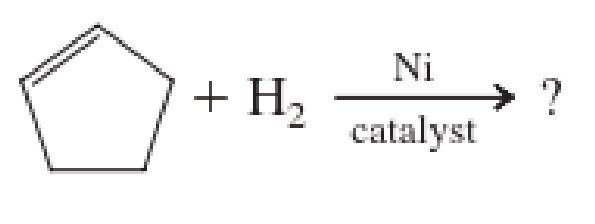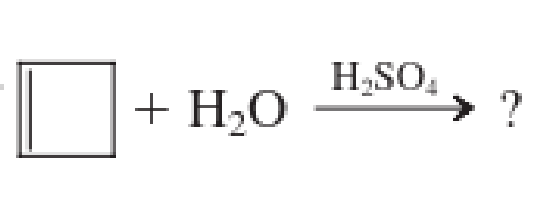
General, Organic, And Biological Chemistry, Hybrid (with Owlv2 Quick Prep For General Chemistry Printed Access Card)
7th Edition
ISBN: 9781305253070
Author: STOKER, H. Stephen
Publisher: Cengage Learning
expand_more
expand_more
format_list_bulleted
Concept explainers
Textbook Question
Chapter 13, Problem 13.77EP
Supply the structural formula of the product in each of the following
- a. CH3—CH=CH—CH3 + Cl2 → ?
- b. CH3—CH—CH=CH2 + HCl → ?


Expert Solution & Answer
Want to see the full answer?
Check out a sample textbook solution
Students have asked these similar questions
Identify the most acidic proton in the compound:
a
d
b
Оа
Ob
Ос
○ d
A Standard Reference Material is certified to contain 94.6 ppm of an organic contaminant in soil. Your analysis gives values of 98.6, 98.4, 97.2, 94.6, and 96.2. Do your results differ from the expected results at the 95% confidence interval?
The percentage of an additive in gasoline was measured six times with the following results: 0.13, 0.12, 0.16, 0.17, 0.20, and 0.11%. Find the 95% confidence interval for the percentage of additive.
Chapter 13 Solutions
General, Organic, And Biological Chemistry, Hybrid (with Owlv2 Quick Prep For General Chemistry Printed Access Card)
Ch. 13.1 - Prob. 1QQCh. 13.1 - Prob. 2QQCh. 13.1 - Prob. 3QQCh. 13.2 - Prob. 1QQCh. 13.2 - Prob. 2QQCh. 13.2 - Prob. 3QQCh. 13.2 - Prob. 4QQCh. 13.3 - Prob. 1QQCh. 13.3 - Prob. 2QQCh. 13.3 - Prob. 3QQ
Ch. 13.3 - Prob. 4QQCh. 13.4 - Prob. 1QQCh. 13.4 - Prob. 2QQCh. 13.5 - Prob. 1QQCh. 13.5 - Prob. 2QQCh. 13.5 - Prob. 3QQCh. 13.6 - Prob. 1QQCh. 13.6 - Prob. 2QQCh. 13.6 - Prob. 3QQCh. 13.7 - Prob. 1QQCh. 13.7 - Prob. 2QQCh. 13.7 - Prob. 3QQCh. 13.8 - Prob. 1QQCh. 13.8 - Prob. 2QQCh. 13.9 - Prob. 1QQCh. 13.9 - Prob. 2QQCh. 13.10 - Prob. 1QQCh. 13.10 - Prob. 2QQCh. 13.10 - Prob. 3QQCh. 13.10 - Prob. 4QQCh. 13.10 - Prob. 5QQCh. 13.11 - Prob. 1QQCh. 13.11 - Prob. 2QQCh. 13.11 - Prob. 3QQCh. 13.11 - Prob. 4QQCh. 13.11 - Prob. 5QQCh. 13.12 - Prob. 1QQCh. 13.12 - Prob. 2QQCh. 13.12 - Prob. 3QQCh. 13.12 - Prob. 4QQCh. 13.12 - Prob. 5QQCh. 13.13 - Prob. 1QQCh. 13.13 - Prob. 2QQCh. 13.13 - Prob. 3QQCh. 13.14 - Prob. 1QQCh. 13.14 - Prob. 2QQCh. 13.14 - Prob. 3QQCh. 13.14 - Prob. 4QQCh. 13.15 - Prob. 1QQCh. 13.15 - Prob. 2QQCh. 13.15 - Prob. 3QQCh. 13.15 - Prob. 4QQCh. 13.16 - Prob. 1QQCh. 13.16 - Prob. 2QQCh. 13 - Classify each of the following hydrocarbons as...Ch. 13 - Classify each of the following hydrocarbons as...Ch. 13 - Prob. 13.3EPCh. 13 - Prob. 13.4EPCh. 13 - Prob. 13.5EPCh. 13 - Prob. 13.6EPCh. 13 - Prob. 13.7EPCh. 13 - Prob. 13.8EPCh. 13 - Prob. 13.9EPCh. 13 - What is the molecular formula for each of the...Ch. 13 - Prob. 13.11EPCh. 13 - Prob. 13.12EPCh. 13 - What is wrong, if anything, with the following...Ch. 13 - Prob. 13.14EPCh. 13 - Prob. 13.15EPCh. 13 - Prob. 13.16EPCh. 13 - Prob. 13.17EPCh. 13 - Prob. 13.18EPCh. 13 - Draw a condensed structural formula for each of...Ch. 13 - Draw a condensed structural formula for each of...Ch. 13 - The following names are incorrect by IUPAC rules....Ch. 13 - The following names are incorrect by IUPAC rules....Ch. 13 - Prob. 13.23EPCh. 13 - Prob. 13.24EPCh. 13 - Prob. 13.25EPCh. 13 - Classify each of the following compounds as...Ch. 13 - Prob. 13.27EPCh. 13 - How many hydrogen atoms are present in a molecule...Ch. 13 - Prob. 13.29EPCh. 13 - Draw a line-angle structural formula for each of...Ch. 13 - Prob. 13.31EPCh. 13 - Prob. 13.32EPCh. 13 - Prob. 13.33EPCh. 13 - Prob. 13.34EPCh. 13 - Prob. 13.35EPCh. 13 - Prob. 13.36EPCh. 13 - Prob. 13.37EPCh. 13 - Prob. 13.38EPCh. 13 - For each of the following pairs of alkenes,...Ch. 13 - Prob. 13.40EPCh. 13 - Prob. 13.41EPCh. 13 - Prob. 13.42EPCh. 13 - Prob. 13.43EPCh. 13 - Prob. 13.44EPCh. 13 - Prob. 13.45EPCh. 13 - Prob. 13.46EPCh. 13 - For each molecule, indicate whether cistrans...Ch. 13 - For each molecule, indicate whether cistrans...Ch. 13 - Prob. 13.49EPCh. 13 - Prob. 13.50EPCh. 13 - Prob. 13.51EPCh. 13 - Draw a structural formula for each of the...Ch. 13 - Prob. 13.53EPCh. 13 - Prob. 13.54EPCh. 13 - Prob. 13.55EPCh. 13 - Prob. 13.56EPCh. 13 - Prob. 13.57EPCh. 13 - Prob. 13.58EPCh. 13 - Why is the number of carbon atoms in a terpene...Ch. 13 - How many isoprene units are present in a....Ch. 13 - Prob. 13.61EPCh. 13 - Indicate whether each of the following statements...Ch. 13 - Prob. 13.63EPCh. 13 - With the help of Figure 13-7, indicate whether...Ch. 13 - Prob. 13.65EPCh. 13 - Prob. 13.66EPCh. 13 - Prob. 13.67EPCh. 13 - Prob. 13.68EPCh. 13 - Prob. 13.69EPCh. 13 - Prob. 13.70EPCh. 13 - Prob. 13.71EPCh. 13 - Prob. 13.72EPCh. 13 - Prob. 13.73EPCh. 13 - Prob. 13.74EPCh. 13 - Prob. 13.75EPCh. 13 - Write a chemical equation showing reactants,...Ch. 13 - Supply the structural formula of the product in...Ch. 13 - Prob. 13.78EPCh. 13 - What reactant would you use to prepare each of the...Ch. 13 - Prob. 13.80EPCh. 13 - Prob. 13.81EPCh. 13 - Prob. 13.82EPCh. 13 - Prob. 13.83EPCh. 13 - Prob. 13.84EPCh. 13 - Prob. 13.85EPCh. 13 - Prob. 13.86EPCh. 13 - Prob. 13.87EPCh. 13 - Prob. 13.88EPCh. 13 - Prob. 13.89EPCh. 13 - Prob. 13.90EPCh. 13 - Prob. 13.91EPCh. 13 - Prob. 13.92EPCh. 13 - Prob. 13.93EPCh. 13 - What are the bond angles about the triple bond in...Ch. 13 - Prob. 13.95EPCh. 13 - Prob. 13.96EPCh. 13 - Prob. 13.97EPCh. 13 - Prob. 13.98EPCh. 13 - Prob. 13.99EPCh. 13 - Prob. 13.100EPCh. 13 - Prob. 13.101EPCh. 13 - Prob. 13.102EPCh. 13 - Prob. 13.103EPCh. 13 - Prob. 13.104EPCh. 13 - Prob. 13.105EPCh. 13 - Prob. 13.106EPCh. 13 - Prob. 13.107EPCh. 13 - Prob. 13.108EPCh. 13 - Assign each of the compounds in Problem 13-107 an...Ch. 13 - Assign each of the compounds in Problem 13-108 an...Ch. 13 - Prob. 13.111EPCh. 13 - Prob. 13.112EPCh. 13 - Prob. 13.113EPCh. 13 - Prob. 13.114EPCh. 13 - Prob. 13.115EPCh. 13 - Write a structural formula for each of the...Ch. 13 - Eight isomeric substituted benzenes have the...Ch. 13 - Prob. 13.118EPCh. 13 - Prob. 13.119EPCh. 13 - Prob. 13.120EPCh. 13 - Prob. 13.121EPCh. 13 - Prob. 13.122EPCh. 13 - Prob. 13.123EPCh. 13 - Prob. 13.124EPCh. 13 - Prob. 13.125EPCh. 13 - For each of the following classes of compounds,...Ch. 13 - Prob. 13.127EPCh. 13 - Prob. 13.128EPCh. 13 - Prob. 13.129EPCh. 13 - Prob. 13.130EP
Knowledge Booster
Learn more about
Need a deep-dive on the concept behind this application? Look no further. Learn more about this topic, chemistry and related others by exploring similar questions and additional content below.Similar questions
- Explain why this data led Rayleigh to look for and to discover Ar.arrow_forward5) Confidence interval. Berglund and Wichardt investigated the quantitative determination of Cr in high-alloy steels using a potentiometric titration of Cr(VI). Before the titration, samples of the steel were dissolved in acid and the chromium oxidized to Cr(VI) using peroxydisulfate. Shown here are the results (as %w/w Cr) for the analysis of a reference steel. 16.968, 16.922, 16.840, 16.883, 16.887, 16.977, 16.857, 16.728 Calculate the mean, the standard deviation, and the 95% confidence interval about the mean. What does this confidence interval mean?arrow_forwardIn the Nitrous Acid Test for Amines, what is the observable result for primary amines? Group of answer choices nitrogen gas bubbles form a soluble nitrite salt yellow oily layer of nitrosoaminearrow_forward
- 3. a. Use the MS to propose at least two possible molecular formulas. For an unknown compound: 101. 27.0 29.0 41.0 50.0 52.0 55.0 57.0 100 57.5 58.0 58.5 62.0 63.0 64.0 65.0 74.0 40 75.0 76.0 20 20 40 60 80 100 120 140 160 180 200 220 m/z 99.5 68564810898409581251883040 115.0 116.0 77404799 17417M 117.0 12.9 118.0 33.5 119.0 36 133 0 1.2 157.0 2.1 159.0 16 169.0 219 170.0 17 171.0 21.6 172.0 17 181.0 1.3 183.0 197.0 100.0 198.0 200. 784 Relative Intensity 2 2 8 ō (ppm) 6 2arrow_forwardSolve the structure and assign each of the following spectra (IR and C-NMR)arrow_forward1. For an unknown compound with a molecular formula of C8H100: a. What is the DU? (show your work) b. Solve the structure and assign each of the following spectra. 8 6 2 ō (ppm) 4 2 0 200 150 100 50 ō (ppm) LOD D 4000 3000 2000 1500 1000 500 HAVENUMBERI -11arrow_forward
- 16. The proton NMR spectral information shown in this problem is for a compound with formula CioH,N. Expansions are shown for the region from 8.7 to 7.0 ppm. The normal carbon-13 spec- tral results, including DEPT-135 and DEPT-90 results, are tabulated: 7 J Normal Carbon DEPT-135 DEPT-90 19 ppm Positive No peak 122 Positive Positive cus и 124 Positive Positive 126 Positive Positive 128 No peak No peak 4° 129 Positive Positive 130 Positive Positive (144 No peak No peak 148 No peak No peak 150 Positive Positive してしarrow_forward3. Propose a synthesis for the following transformation. Do not draw an arrow-pushing mechanism below, but make sure to draw the product of each proposed step (3 points). + En CN CNarrow_forwardShow work..don't give Ai generated solution...arrow_forward
arrow_back_ios
SEE MORE QUESTIONS
arrow_forward_ios
Recommended textbooks for you
 Chemistry for Today: General, Organic, and Bioche...ChemistryISBN:9781305960060Author:Spencer L. Seager, Michael R. Slabaugh, Maren S. HansenPublisher:Cengage Learning
Chemistry for Today: General, Organic, and Bioche...ChemistryISBN:9781305960060Author:Spencer L. Seager, Michael R. Slabaugh, Maren S. HansenPublisher:Cengage Learning World of Chemistry, 3rd editionChemistryISBN:9781133109655Author:Steven S. Zumdahl, Susan L. Zumdahl, Donald J. DeCostePublisher:Brooks / Cole / Cengage Learning
World of Chemistry, 3rd editionChemistryISBN:9781133109655Author:Steven S. Zumdahl, Susan L. Zumdahl, Donald J. DeCostePublisher:Brooks / Cole / Cengage Learning- Chemistry: Matter and ChangeChemistryISBN:9780078746376Author:Dinah Zike, Laurel Dingrando, Nicholas Hainen, Cheryl WistromPublisher:Glencoe/McGraw-Hill School Pub Co
 Introductory Chemistry: An Active Learning Approa...ChemistryISBN:9781305079250Author:Mark S. Cracolice, Ed PetersPublisher:Cengage Learning
Introductory Chemistry: An Active Learning Approa...ChemistryISBN:9781305079250Author:Mark S. Cracolice, Ed PetersPublisher:Cengage Learning Organic And Biological ChemistryChemistryISBN:9781305081079Author:STOKER, H. Stephen (howard Stephen)Publisher:Cengage Learning,
Organic And Biological ChemistryChemistryISBN:9781305081079Author:STOKER, H. Stephen (howard Stephen)Publisher:Cengage Learning,


Chemistry for Today: General, Organic, and Bioche...
Chemistry
ISBN:9781305960060
Author:Spencer L. Seager, Michael R. Slabaugh, Maren S. Hansen
Publisher:Cengage Learning

World of Chemistry, 3rd edition
Chemistry
ISBN:9781133109655
Author:Steven S. Zumdahl, Susan L. Zumdahl, Donald J. DeCoste
Publisher:Brooks / Cole / Cengage Learning

Chemistry: Matter and Change
Chemistry
ISBN:9780078746376
Author:Dinah Zike, Laurel Dingrando, Nicholas Hainen, Cheryl Wistrom
Publisher:Glencoe/McGraw-Hill School Pub Co

Introductory Chemistry: An Active Learning Approa...
Chemistry
ISBN:9781305079250
Author:Mark S. Cracolice, Ed Peters
Publisher:Cengage Learning

Organic And Biological Chemistry
Chemistry
ISBN:9781305081079
Author:STOKER, H. Stephen (howard Stephen)
Publisher:Cengage Learning,
Chapter 4 Alkanes and Cycloalkanes Lesson 2; Author: Linda Hanson;https://www.youtube.com/watch?v=AL_CM_Btef4;License: Standard YouTube License, CC-BY
Chapter 4 Alkanes and Cycloalkanes Lesson 1; Author: Linda Hanson;https://www.youtube.com/watch?v=PPIa6EHJMJw;License: Standard Youtube License